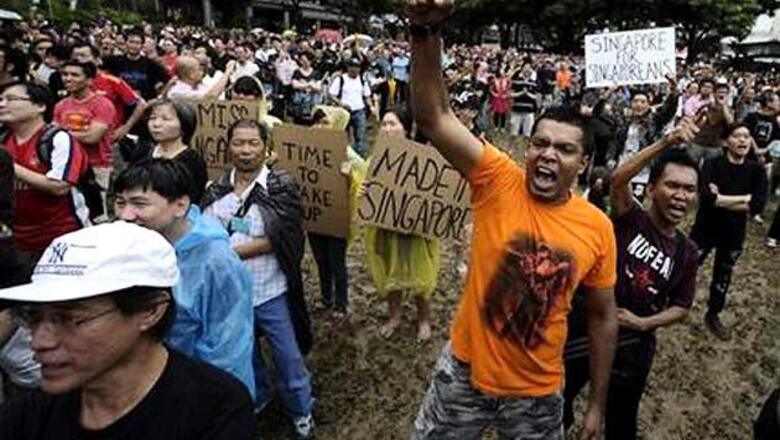
views
Singapore: More than 4000 people took to the streets in Singapore on Saturday in an unprecedented anti-government protest, after the Singapore government announced a change in immigration laws. The government decision came in a process to increase immigration over the next few decades.
Singapore aims to raise the population by 30 per cent by 2030. Many Singapore citizens believe the change in immigration laws will lead to a higher cost of living in the country and will worsen already strained public services. The people are also demanding limitation of unskilled labour immigration in the country.
The chief organizer of the protest, Gilbert Goh, said the protest was a display of citizens' unhappiness over the population plan, which was endorsed in parliament on Feruary. 8. "They want to tell the government, please reconsider this policy. The turnout is a testimony that this policy is flawed and unpopular on the ground," he said.
Such demonstrations are rare in the Southeast Asian country, known for its image of political stability and efficient governance, with the ruling People's Action Party stifling opposition voices and placing tight controls on public protests.
According to the plan, the government will bolster infrastructure and social programs to accommodate a projected population of 6.5 million to 6.9 million by 2030 - a marked increase from the current population of 5.3 million. Of the projected 2030 population, non-foreigners would form between 3.6 and 3.8 million, slightly more than half of the total.
The issue triggered five days of intense debate in parliament, with both opposition and some PAP legislators expressing concerns that an immigration inflow would hurt public infrastructure and dilute the Singaporean identity. But the plan was eventually approved by a wide majority.
The plan to admit more new citizens comes amid government concerns that the current population will not help ensure the economy remains robust, as Singapore grapples with a falling birthrate and aging baby boomers.
"In my view in 2030, I think 6 million will not be enough to meet Singaporeans' needs as our population ages because of this problem of the baby boomers and bulge of aging people," Prime Minister Lee Hsien Loong said in parliament on February 8, adding that 6.9 million was not a target but a number to be used to help plan for infrastructure.
Although Singapore continues to bring in hundreds of thousands of immigrants from countries such as Indonesia and China to work as maids and construction workers, it also attracts thousands of higher-income foreigners who find the country's high standard of living and stability appealing.
But the influx has strained public services, with complaints of transport overcrowding, and caused property prices to escalate, sparking concerns among locals about the rising cost of living and fostering a deep resentment toward foreigners.
"Immigrants come at such a fast pace that they're not able to assimilate," said Samantha Chia, 32, one of the protest speakers. "It's unfair for them as well and a lose-lose situation."
Although economic prosperity has turned Singapore into a bustling metropolis, critics have noted the government's continuous pursuit of growth at all cost.
"We want the government to put the vast resources that are at their disposal at the service of us, the people," said one of Saturday's protesters, Vincent Wijeysingha, a university lecturer and member of the opposition Singapore Democratic Party. "Because we are not machines and our neighborhoods are not factories, and our island is not a hotel."




















Comments
0 comment